
Diary: The garden in November 2000

 | Diary: The garden in November 2000 |

|
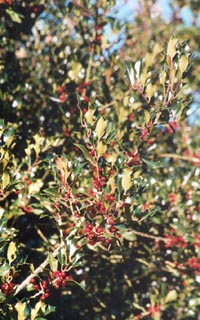
The colder weather continues and on the 1st we had thunder and lightning with showers of hail. Many wild things use our house from time to time. As well as the bats, lots of spiders and beetles we do get the odd bird. Being an old house there are many places where small creatures can gain access. Birds, especially wrens and blue tits shelter from the cold and wet under the eaves. They will roost there at night and sometimes lose they way and can be heard scuffling about the roof space. This has happened again but the bird got further into the house than usual and found its way into bathroom. Somehow it got into the space behind the bath! Before starting to dismantle things to release it I remembered there was a small hole where a waste pipe entered the cupboard under the wash basin. I opened the cupboard doors to let in light and, as an escape route, the bathroom window. We stood watching to see what would happen. It was not long before a blue tit appeared at the hole, looking rather bewildered and covered with dust and cobwebs. It summed up the situation fairly quickly and made a successful escape through the window. In the garden the blackbirds are feeding on a plentiful supply of Cotoneaster berries. 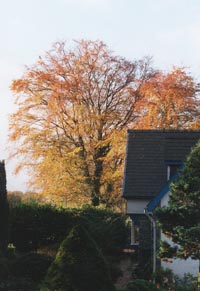
The colour of the remaining leaves on the beech trees has intensified. Along the roadsides, and embankments of the A55 Expressway, stands of birch are also very colourful. On the road to Llanbedrgoch there is a wet field (the 1999 Eisteddfod field) that usually, at this time of year, has on it curlews and lapwings. We have been keeping a look out for them and saw them for the first time this autumn on the 3rd. There was a small group of about 10 lapwings and a larger group of 20 curlews. The numbers will probably build up during the winter; we have seen much larger numbers in other years. We were pleased to see today the return of the male Norman pheasant. He has not been seen or heard for several months. The female has been here for a few weeks and we wondered if the male had survived the summer. They are both here now and come to feed nearly every day; they are the same birds because they know their way around the garden and where the feeding stations are kept. We hope that they will be able to breed next year and, if the weather is better, to successfully rear the chicks having failed this year.
The mistle thrushes have returned. On the 13th I spotted 2 in the trees along the Drive, I heard them first making their characteristic calls while I was in the garden making the 9 o'clock weather observations. It is a good time to see and hear what birds are around.
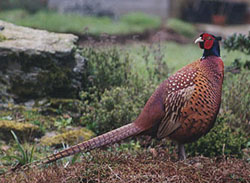
I also put out the day's food and the birds are used to this regularity and wait for me in nearby tree branches and bushes. There is a good supply of holly berries this year and, within a day or two, the mistle thrushes had found them and were enjoying them along with the blackbirds. It is unlikely that any will be left to decorate the house at Christmas! Not that we mind too much, it is better for the birds to have them. On the 17th Patricia spotted a small flock of long-tailed tits in the trees. They were nice to see again but were only passing through the garden. We usually see them this time of year but they rarely stay. We did once have a pair nest in a large kale plant on the vegetable plot! Blackbirds have been around in only small numbers until today. We saw at least 6 turning over leaves along the Drive. I expect we will have more in the garden later in the year. There was also a flock of up to 100 starlings in the field during the day. We have yet to see them in the large numbers that we have seen in the past. After saying that we had not seen many wood pigeons, there are usually 1 or 2, we saw 6. They come to feed on the beech seed under the trees in the garden. We have been hearing and occasionally seeing our resident tawny owl. The best time is just before dawn, or at dusk. Sometimes we hear him call during the night and it will perch on the house from time to time. I think he is hunting for mice that are attracted by the crumbs dropped from the bird feeders. There is a female around also as we sometimes hear the two calling to each other.
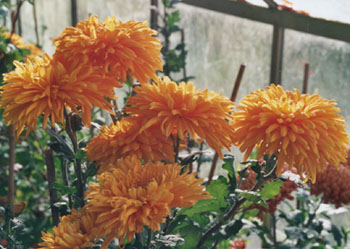
The weather is continuing to be wet and dismal. The ground remains waterlogged and no work can be done that involves handling, or even standing on, soil. In the greenhouse on the 19th the last of the grapes needed picking, as there was some mould developing on them. They have been excellent this year and are now sweeter than at any time. The leaves have turned yellow but have not yet started to drop. The chrysanthemums too are doing well and we have picked several bunches for vases in the house. There have been good blooms of Gold Plate and the large bronze incurve Lilian Shoesmith. The bright yellow Fred Thompson and the pale orange-yellow Olga Paterson are coming along well and will be ready for cutting in a few days. The propagating frame is full of rooting cuttings and the benches have already rooted plants of fuchsias and lavenders for over-wintering. Stock plants are also kept of those that could be vulnerable to wet and cold. Still seeking winter hiding places are queen wasps. For several mornings I have been coming across them in the garden shed. I have even seen them on scraps of bread kept for the birds. The orchids have spent the summer on the large window ledge in the kitchen. Both the Cypripediums and theCymbidiums have stared to produce flower buds. The Cypripediums will soon be moved to the lounge where it is warmer. The Cymbidiums will remain in the kitchen. We are pleased to say that a Cypripedium plant is now 'north of the border' in Dundee in the home of our eldest son. We have had another bird in the house; it is the time of year! This was a wren found in the kitchen working its way over the orchids on the window ledge. We think it got in through a small opening of an extractor fan that had not closed properly on switch-off. It spent most of the afternoon in the house and seemed reluctant to leave. Eventually it escaped through a window; we had opened for it, leaving behind several droppings below its perching places.
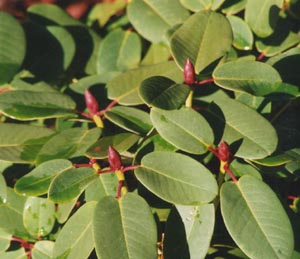
Heathers (Ericas) are still flowering although not in the profusion of previous months. E. vegans Mrs D F Maxwell have flowers as well as the white and purple Daboecias. We are looking out for Erica December Red to start flowering, it is well into bud as are the Erica carnea varieties. In the Rhododendron garden the shrubs are all looking fresh with their new leaves and buds ready for next season. There is such a variety of leaf shape and colour that they are always worth a glance at any time of the year. 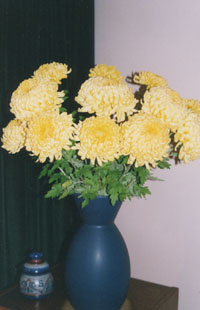 Also out are the silvery-white plumes of the Pampas grass Cortaderia, near the entrance to the wood, that look very bedraggled when it is wet but soon dry out if it stops raining. Also some naturally seeded snapdragons Antirrhinum, these have been popping up for some years now where they seem to flower well into the autumn. There are also some Cistus flowers around the garden, not many now, but considering the wet and windy weather it seems quite remarkable. We do not have any Christmas roses Helleborus niger to look forward to. We have tried to grow them in the past and had a few flowers but the plants did not survive for long. Perhaps one day we will find a place that they like and have success.
Also out are the silvery-white plumes of the Pampas grass Cortaderia, near the entrance to the wood, that look very bedraggled when it is wet but soon dry out if it stops raining. Also some naturally seeded snapdragons Antirrhinum, these have been popping up for some years now where they seem to flower well into the autumn. There are also some Cistus flowers around the garden, not many now, but considering the wet and windy weather it seems quite remarkable. We do not have any Christmas roses Helleborus niger to look forward to. We have tried to grow them in the past and had a few flowers but the plants did not survive for long. Perhaps one day we will find a place that they like and have success.
There seem to be more birds interested in the feeders. I have put up another larger peanut feeder and on the 20th was already attracting several blue tits, great tits, coal tits and a great spotted woodpecker. I have also started feeding bird cake. I make this up in batches from 750g dripping and 1500g bird cake mixture obtainable from CJ Wildbird Foods. The mixture contains peanut flour and seed, which can be customised with the addition of anything you can spare from the kitchen. To make the cake melt the fat in a large saucepan, remove from the heat and slowly add the cake mixture and stir well. Before the mixture cools too much, and sets, I put it into moulds made from empty 400-ml cans. 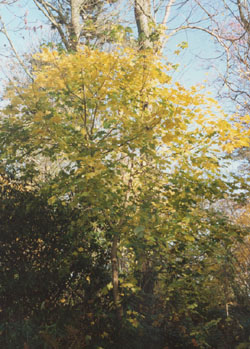 These have the top and bottom removed and cut longitudinally. Put on thick rubber bands and place on a metal tray. It is a good idea to wear gloves, as the metal cans can be sharp! Spoon in the mixture and allow to set. The amounts given are enough to make 8 cakes. These can be stored in a cool place or, for a longer period, in a refrigerator or deep freeze. The cakes are best hung up in the garden in nets or in one of the purpose made cake feeders. The birds love it! My advice is to think about making the next batch straight away. Patricia spotted a group of redwings along the Pentraeth to Beaumaris road during the morning. We kept a look out here and at lunchtime saw several arrive to perch in the treetops. Our first sighting of the season.
These have the top and bottom removed and cut longitudinally. Put on thick rubber bands and place on a metal tray. It is a good idea to wear gloves, as the metal cans can be sharp! Spoon in the mixture and allow to set. The amounts given are enough to make 8 cakes. These can be stored in a cool place or, for a longer period, in a refrigerator or deep freeze. The cakes are best hung up in the garden in nets or in one of the purpose made cake feeders. The birds love it! My advice is to think about making the next batch straight away. Patricia spotted a group of redwings along the Pentraeth to Beaumaris road during the morning. We kept a look out here and at lunchtime saw several arrive to perch in the treetops. Our first sighting of the season.
The month and the autumn continue to be very wet and turn out to be the wettest on record. We have had no dry spells when work could be done in the garden; the vegetable plot has not been dug over for the third consecutive autumn. Indeed fine days, or even a few hours, have been at a premium to do anything at all. The greenhouse is a sanctuary from the incessant rain. Here cuttings for next year can be tended as can the last of the chrysanthemums. The 25th was a terrible day with gale force winds, thunder and lightning, hail and later in the day heavy rain. All the leaves have fallen from the trees except on the Norway maple and our beech hedge. The hedge leaves will remain attached all winter but the now yellow Norway maple will soon drop. We have many of these in the wood, about 10m tall that turn the wood yellow in the autumn. They all originate from one tall parent tree that must have been planted when the wood was established over 100 years ago. The reason why we now have so many is that they grew up when many of the elms were felled following Dutch Elm Disease in the 1970's. The open spaces allowed seedlings to grow up and that is why the wood now turns yellow in the autumn.
Document dated: 2 December 2000. This page is part of the site maintained at http://www.llansadwrn-wx.co.uk
Copyright ©: 2000 Donald and Patricia Perkins